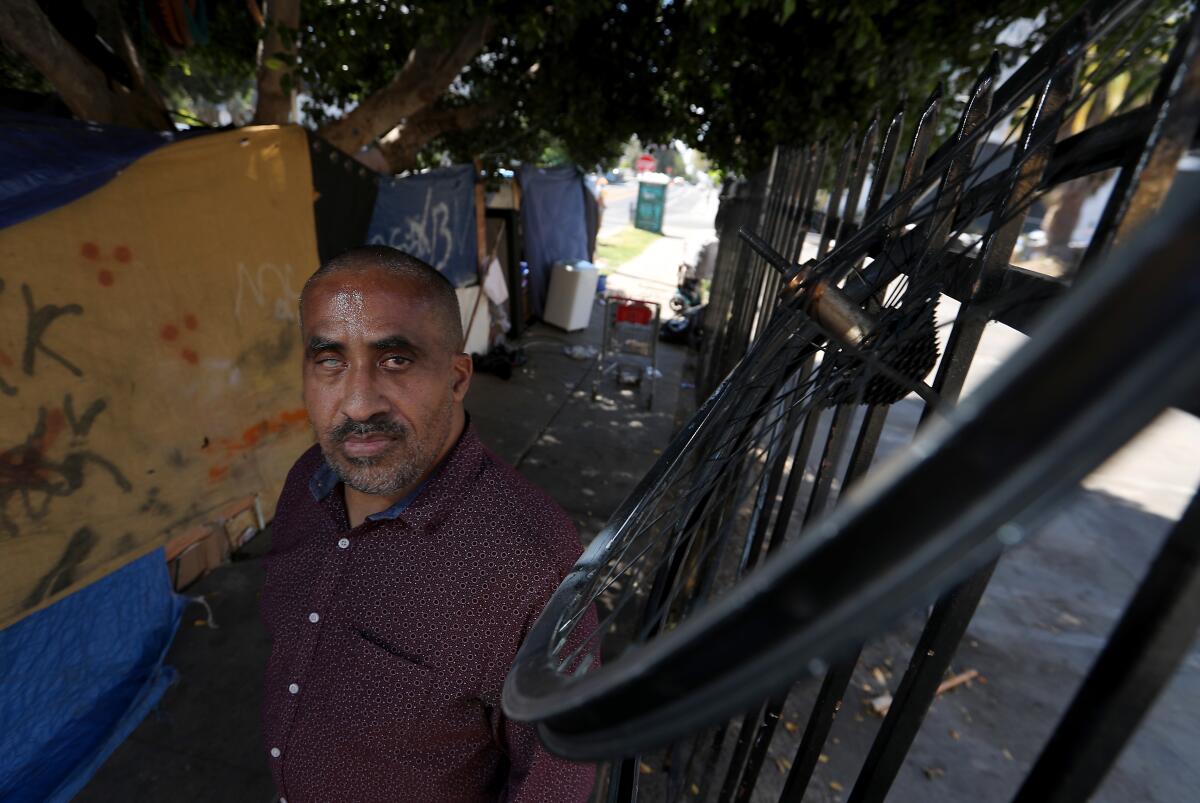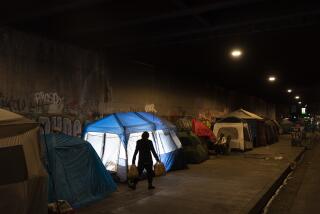He went from Yale to Wall Street to homelessness. Now he’s rising back up

- Share via
For years, Shawn Pleasants did nothing but rise up.
He was high school valedictorian, went to Yale, landed banking jobs on Wall Street, started his own business.
And then, for years, he did nothing but fall.
Lost his business, his home, the car he was living in, and landed on the streets of Los Angeles.
For about six years, home for him and his common-law husband was a lean-to near 7th and Hobart in Koreatown. And like a lot of L.A.’s sizable homeless population, Pleasants was addicted to methamphetamine, a cheap and abundantly available drug.
“It always felt to me like I’d fallen off a fire escape, and once you get on the ground, the ladder is 12 feet up in the air,” Pleasants told me. “I always thought, ‘If I could just get to that first step.’ But the first step is so far away.”
Not anymore.
Pleasants found the bottom rung of that ladder in November of 2019, when he went into a residential rehab program. He now lives in an apartment with his husband and has been drug-free for more than 500 days.
We’ve heard endless policy discussions about shortages of housing and mental health services, but not nearly as much about the addiction epidemic. I don’t see how we’ll ever make a serious dent in the growing homeless population without a better way of freeing people on the streets — many of whom also struggle with mental illness — from the grips of drugs and alcohol.
What are we doing right, what are we doing wrong, and what should we do differently?
These are the questions I asked Pleasants and others.
“We haven’t treated substance abuse and access to mental health care the same way we would cardiac arrest,” said Sarah Dusseault, a board member with the Los Angeles Homeless Services Agency.
“If you scrape your knee,” Dusseault said, you’ve got your choice of multiple conveniently located urgent care centers, among other options.
But addiction treatment is harder to come by — and difficult to access and pay for. Dusseault said that when someone finally tells an outreach worker he or she is ready for rehab, the chance is often lost because there is no bed available at that moment.
“I think there needs to be a cultural change, where we don’t see someone who’s using drugs as the scum of the earth and not worthy of anything, and they got themselves into this and so they get what they deserve,” said Dr. Susan Partovi of Homeless Healthcare Los Angeles. She has practiced street medicine for many years and estimates that the vast majority of her patients — many of them reeling from one trauma or another — have an addiction issue.
Partovi said there’s hope that medication aimed at reducing meth use can help, and she’s also an advocate of safe, legal drug-use sites such as those operating in Denmark and Portugal.
Her colleague Mark Casanova, who traveled to Copenhagen to research their system, said drug use there is treated as a public health issue rather than a criminal problem, and there’s a recognition that not all users are ready for rehab.
Casanova said that anyone who’s using can go to a safe, supervised facility and legally use drugs, which helps prevent overdoses, moves drug use off the streets, and links clients with rehab and other services that might help them turn their lives around.
It’s a containment and harm-reduction strategy, Casanova said. And it’s the thinking behind California’s SB 57, introduced in December by several legislators, which would make overdose prevention programs available in Los Angeles County and in Oakland and San Francisco.
The bill argues that such programs operate in 10 countries and are “effective in reducing overdose deaths and HIV transmission, and in increasing access to counseling, treatment, and other risk reduction services.” Research has also demonstrated that they help “decrease use of emergency medical services, reduce public drug use, reduce syringe debris, and do not increase crime or drug use.”
Pleasants himself doesn’t claim to have all the answers. But the story of why he started using — and how he stopped — provides insights.
Pleasants, who is African American, grew up mainly in Texas, a nerdy loner, as he describes it, with multiple health problems and poor vision from birth. He had the good fortune of a stable, loving family, and he did so well in school that he had his choice of elite colleges.
But after Yale he found that he hated his Wall Street job, and about that time, he was jolted by the death of his younger sister in a fire in Texas. He left banking to start a small company that ultimately dissolved, and his mother’s death from cancer left him feeling lost.
When he could no longer pay the rent on his home in Highland Park, he thought he’d quickly find work and rebuild. But it didn’t happen, so he couch-surfed, thankful he at least still had a car, which was often where he and David slept. But the vehicle was impounded because he kept getting parking tickets despite his disabled placard, and for six years, home was a lean-to in Koreatown.
Some people develop an addiction that leads to homelessness.
Pleasants became addicted to drugs because of the despair of homelessness.
Whatever the stressors, Pleasants said, “people turn to drugs for a reason.” You come to believe, he said, “that it’s the one thing that will not let you down.” Meth is easy to get and cheap, he said. A buck or two will fix you up.
“With the first hit you think everything’s going to be OK. It’s freedom, an escape,” said Pleasants, adding that meth also had the benefit of keeping you awake at night to fend off attacks.
Pleasants found a community of trusted friends and learned to negotiate his way around turf wars among drug dealers. But there’s always the threat that your meth might be laced with something lethal, and danger hides in the shadows. Once, a newcomer to the street insisted Pleasants share his stash, and when he refused, he was stabbed in the neck with a screwdriver.
Pleasants also got pneumonia twice, and his vision deteriorated. He said he spent about $600 of his monthly disability income of $1,000 on storage for his belongings, $100 on food and $300 on drugs. When he first landed in Koreatown, he avoided putting up a tent, because that would have indicated he expected to stay a while. But before long, he couldn’t see how he’d ever get a job or a decent place to live.
“I’m a Yale grad, and I’m thinking, ‘How can I even explain to anyone the situation I’ve gotten myself into?’ It’s hard to ask someone for help for something you feel you’re responsible for because of the choices you’ve made,” Pleasants said.
When outreach workers came by, there was no offer of rehab, Pleasants said. They had water or food or clean socks, or sometimes a cot in a shelter or a temporary motel room. But that meant losing most of your belongings, leaving the one place in which you had figured out how to survive, and moving to a strange place with no real hope of any long-term solutions.
So how did he turn it around?
In 2019, he was featured briefly in a story on CNN about Los Angeles homelessness. Kim Hershman, a local attorney who had attended Yale at the same time as Pleasants, saw the video and went looking for him.
“She said, ‘What do you need?’” Pleasants recalls, and she kept coming back for three weeks, earning his trust and David’s as well.
Hershman, who is also African American, began making calls to try to get some help, but found one hurdle after another in a system full of inconsistencies and hampered by limited resources. But she didn’t give up. She was essentially doing the kind of intensive, individualized case management that most homeless people need but don’t have access to.
Hershman eventually persuaded Pleasants and his partner to come stay at her house briefly while she began setting up medical appointments. Pleasants went to an eye doctor who told him if he’d waited much longer, he might have gone blind. David ended up in surgery for a heart condition.
“It was all very difficult, more so than I ever would have anticipated,” said Hershman, who shopped for residential rehab programs before taking both of them to a Tarzana facility. Hershman told me that when they arrived, they were told they’d be on a waiting list for those with Medi-Cal. Hershman then pulled out her checkbook.
“They said it was going to cost $10,877 per person per month,” Pleasants recalled. “She said fine, and suddenly we were No. 1 on the list.”
Eventually Medi-Cal covered the bills, but residential rehab can be very difficult to get without money. Pleasants said he made it through four days of detox without too much trouble, then struggled a bit in the residential program as he tried to envision a new life for himself on the other side.
But he kept telling himself, “If I made it this far...” Two months of round-the-clock care that included classes, counseling and behavior modification were followed by six months in a sober-living house. David struggled a bit more than he did, but they both made it through and now live in a Section 8 apartment in Van Nuys.
Pleasants said he’s still dealing with the trauma of being on the streets for so long, but he is hoping to find a career in which he can influence public policy improvements. He just completed a training program at Southwest Los Angeles College called Careers for a Cause, in which participants learn how to used their experiences to help others.
He’s on boards and committees, staying connected to the homeless advocacy group Ktown for All and St. James Episcopal Church, which helped him when he was down. And he is trying to follow his late mother’s advice to just keep moving forward.
One day we walked several blocks from St. James to where he had lived for six years. Pleasants found an old friend — Salvador — who still lives in a tent that was next to Pleasants’ old spot. They hugged and as we walked away, Pleasants seemed all the more determined to help others reach up to the bottom rung of the ladder.
steve.lopez@latimes.com
More to Read
Sign up for Essential California
The most important California stories and recommendations in your inbox every morning.
You may occasionally receive promotional content from the Los Angeles Times.











